The Effect of the Wenchuan and Lushan Earthquakes on the Size Distribution of Earthquakes along the Longmenshan Fault
Abstract
1. Introduction
2. Data and Postulates
3. Methods
3.1. Completeness Magnitude (MC) and b Value Estimation
3.2. Estimation of the Frequency-Magnitude Distribution (FMD) Extrapolation
- (1)
- Calculate the b value for all Mcut from Mcmin to the highest Mcut for which Nmin events are still sampled.
- (2)
- Divide the standard deviation by the largest individual b value uncertainty for each possible Mcut, and for each Mcut, this value is the NLIndex.
- (3)
- Divide the NLIndex for each Mcut by the number of estimated b values to weight the result by data density. Please check Italics.
- (4)
- Find the minimum weighted NLIndex to find the best MC that produces the most linear FMD fit.
3.3. Akaike Information Criterion
3.4. Kriging Interpolation
4. Results and Analysis
4.1. Completeness Magnitude (MC) and Linearity Assessment of Frequency-Magnitude Distribution (FMD)
4.2. Time-Space Analysis of b Values
4.3. Evolution of Images of Aftershock Activity Depicted by Focal Depth
5. Discussion
6. Conclusions
Author Contributions
Funding
Data Availability Statement
Acknowledgments
Conflicts of Interest
References
- Jia, K.; Zhou, S.; Zhuang, J.; Jiang, C. Possibility of the independence between the 2013 Lushan earthquake and the 2008 Wenchuan earthquake on Longmen Shan fault, Sichuan, China. Seismol. Res. Lett. 2014, 85, 60–67. [Google Scholar] [CrossRef]
- Zhang, Y.Q.; Dong, S.W.; Hou, C.T.; Shi, J.S.; Wu, Z.H.; Li, H.L.; Sun, P.; Liu, G.; Li, J. Seismogenic structure of the April 20, 2013, Lushan Ms7 earthquake in Sichuan. Acta Geol. Sin. Engl. Ed. 2013, 87, 633–645. [Google Scholar]
- Li, Y.Q.; Jia, D.; Wang, M.M.; Shaw, J.H.; He, J.K.; Lin, A.M.; Xiong, L.; Rao, G. Structural geometry of the source region for the 2013 Mw 6.6 Lushan earthquake: Implication for earthquake hazard assessment along the Longmen Shan. Earth Planet. Sci. Lett. 2014, 390, 275–286. [Google Scholar] [CrossRef]
- Du, F.; Long, F.; Ruan, X.; Yi, G.X.; Wu, J. The M7.0 Lushan earthquake and the relationship with the M8.0 Wenchuan earthquake in Sichuan, China. Chin. J. Geophys. 2013, 56, 1772–1783. [Google Scholar]
- Parsons, T.; Segou, M. Stress, distance, magnitude, and clustering influences on the success or failure of an aftershock forecast: The 2013 M 6.6 Lushan earthquake and other examples. Seismol. Res. Lett. 2014, 85, 44–51. [Google Scholar] [CrossRef]
- Zhu, S. Is the 2013 Lushan earthquake (Mw = 6.6) a strong aftershock of the 2008 Wenchuan, China mainshock (Mw= 7.9)? J. Geodyn. 2016, 99, 16–26. [Google Scholar] [CrossRef]
- Toda, S.; Stein, R.S.; Lin, J. Widespread seismicity excitation throughout central Japan following the 2011 M= 9.0 Tohoku earthquake and its interpretation by Coulomb stress transfer. Geophys. Res. Lett. 2011, 38. [Google Scholar] [CrossRef]
- Wedmore, L.; Walker, J.F.; Roberts, G.P.; Sammonds, P.; McCaffrey, K.; Cowie, P. A 667 year record of coseismic and interseismic Coulomb stress changes in central Italy reveals the role of fault interaction in controlling irregular earthquake recurrence intervals. J. Geophys. Res. Solid Earth 2017, 122, 5691–5711. [Google Scholar] [CrossRef]
- Verdecchia, A.; Pace, B.; Visini, F.; Scotti, O.; Peruzza, L.; Benedetti, L. The role of viscoelastic stress transfer in long-term earthquake cascades: Insights after the central Italy 2016–2017 seismic sequence. Tectonics 2018, 37, 3411–3428. [Google Scholar] [CrossRef]
- Kilb, D.; Gomberg, J.; Bodin, P. Aftershock triggering by complete Coulomb stress changes. J. Geophys. Res. Solid Earth 2002, 107, ESE 2-1–ESE 2-14. [Google Scholar] [CrossRef]
- Toda, S.; Stein, R.S.; Beroza, G.C.; Marsan, D. Aftershocks halted by static stress shadows. Nat. Geosci. 2012, 5, 410–413. [Google Scholar] [CrossRef]
- DeVries, P.M.; Viégas, F.; Wattenberg, M.; Meade, B.J. Deep learning of aftershock patterns following large earthquakes. Nature 2018, 560, 632–634. [Google Scholar] [CrossRef] [PubMed]
- Utsu, T.; Ogata, Y. The centenary of the Omori formula for a decay law of aftershock activity. J. Phys. Earth 1995, 43, 1–33. [Google Scholar] [CrossRef]
- Ogata, Y. Statistical models for earthquake occurrences and residual analysis for point processes. J. Am. Stat. Assoc. 1988, 83, 9–27. [Google Scholar] [CrossRef]
- Ogata, Y. Space-time point-process models for earthquake occurrences. Ann. Inst. Stat. Math. 1998, 50, 379–402. [Google Scholar] [CrossRef]
- Gulia, L.; Rinaldi, A.; Tormann, T.; Vannucci, G.; Enescu, B.; Wiemer, S. The Effect of a Mainshock on the Size Distribution of the Aftershocks. Geophys. Res. Lett. 2018, 45, 13277–13287. [Google Scholar] [CrossRef]
- Gutenberg, B.; Richter, C.F. Frequency of earthquakes in California. Bull. Seismol. Soc. Am. 1944, 34, 185–188. [Google Scholar] [CrossRef]
- Wech, A.G.; Creager, K.C.; Houston, H.; Vidale, J.E. An earthquake-like magnitude-frequency distribution of slow slip in northern Cascadia. Geophys. Res. Lett. 2010, 37. [Google Scholar] [CrossRef]
- El-Isa. Continuous-cyclic variations in the b-value of the earthquake frequency-magnitude distribution. Earthquake Science 2013, 26(5), 301–320. [Google Scholar] [CrossRef][Green Version]
- Nuannin, P.; Kulhanek, O.; Persson, L. Spatial and temporal b value anomalies preceding the devastating off coast of NW Sumatra earthquake of December 26, 2004. Geophys. Res. Lett. 2005, 32. [Google Scholar] [CrossRef]
- Amitrano, D. Brittle-ductile transition and associated seismicity: Experimental and numerical studies and relationship with the b value. J. Geophys. Res. Solid Earth 2003, 108. [Google Scholar] [CrossRef]
- Goebel, T.H.W.; Schorlemmer, D.; Becker, T.W.; Dresen, G.; Sammis, C.G. Acoustic emissions document stress changes over many seismic cycles in stick-slip experiments. Geophys. Res. Lett. 2013, 40, 2049–2054. [Google Scholar] [CrossRef]
- Spada, M.; Tormann, T.; Wiemer, S.; Enescu, B. Generic dependence of the frequency-size distribution of earthquakes on depth and its relation to the strength profile of the crust. Geophys. Res. Lett. 2013, 40, 709–714. [Google Scholar] [CrossRef]
- Schorlemmer, D.; Wiemer, S.; Wyss, M. Variations in earthquake-size distribution across different stress regimes. Nature 2005, 437, 539. [Google Scholar] [CrossRef]
- Gulia, L.; Wiemer, S. The influence of tectonic regimes on the earthquake size distribution: A case study for Italy. Geophys. Res. Lett. 2010, 37. [Google Scholar] [CrossRef]
- Bachmann, C.E.; Wiemer, S.; Goertz-Allmann, B.; Woessner, J. Influence of pore-pressure on the event-size distribution of induced earthquakes. Geophys. Res. Lett. 2012, 39. [Google Scholar] [CrossRef]
- Zhao, Y.; Wu, Z. Mapping the b-values along the Longmenshan fault zone before and after the 12 May 2008, Wenchuan, China, Ms 8.0 earthquake. Nat. Hazards Earth Syst. Sci. 2008, 8, 1375–1385. [Google Scholar] [CrossRef]
- Zhang, S.; Zhou, S. Spatial and temporal variation of b-values in southwest China. Pure Appl. Geophys. 2016, 173, 85–96. [Google Scholar] [CrossRef]
- Liu, Y.; Pei, S.; Pei, S. Temporal and spatial variation of b-value before and after Wenchuan earthquake and its tectonic implication. Chin. J. Geophys. 2017, 60, 2104–2112. [Google Scholar]
- Shi, H.X.; Meng, L.Y.; Zhang, X.M.; Chang, Y.; Yang, Z.T.; Xie, W.Y.; Hattori, K.; Han, P. Decrease in b value prior to the Wenchuan earthquake (M(s) 8.0). Chin. J. Geophys. Chin. Ed. 2018, 61, 1874–1882. [Google Scholar]
- Zhao, B.; Yang, G.; Wang, J.; Dong, F. Research on b-Values Based on Fault Buffers. Pure Appl. Geophys. 2020, 177, 71–80. [Google Scholar] [CrossRef]
- Stein, R.S.; Barka, A.A.; Dieterich, J.H. Progressive failure on the North Anatolian fault since 1939 by earthquake stress triggering. Geophys. J. Int. 1997, 128, 594–604. [Google Scholar] [CrossRef]
- Mallman, E.P.; Zoback, M.D. Assessing elastic Coulomb stress transfer models using seismicity rates in southern California and southwestern Japan. J. Geophys. Res. Solid Earth 2007, 112. [Google Scholar] [CrossRef]
- Delescluse, M.; Chamot-Rooke, N.; Cattin, R.; Fleitout, L.; Trubienko, O.; Vigny, C. April 2012 intra-oceanic seismicity off Sumatra boosted by the Banda-Aceh megathrust. Nature 2012, 490, 240–244. [Google Scholar] [CrossRef]
- Durand, V.; Bouchon, M.; Karabulut, H.; Marsan, D.; Schmittbuhl, J. Link between Coulomb stress changes and seismic activation in the eastern Marmara sea after the 1999, Izmit (Turkey), earthquake. J. Geophys. Res. Solid Earth 2013, 118, 681–688. [Google Scholar] [CrossRef]
- Sumy, D.F.; Cochran, E.S.; Keranen, K.M.; Wei, M.; Abers, G.A. Observations of static Coulomb stress triggering of the November 2011 M5. 7 Oklahoma earthquake sequence. J. Geophys. Res. Solid Earth 2014, 119, 1904–1923. [Google Scholar] [CrossRef]
- Zuniga, F.R.; Wyss, M. Most-and least-likely locations of large to great earthquakes along the Pacific coast of Mexico estimated from local recurrence times based on b-values. Bull. Seismol. Soc. Am. 2001, 91, 1717–1728. [Google Scholar] [CrossRef]
- Nanjo, K.; Hirata, N.; Obara, K.; Kasahara, K. Decade-scale decrease in b value prior to the M9-class 2011 Tohoku and 2004 Sumatra quakes. Geophys. Res. Lett. 2012, 39. [Google Scholar] [CrossRef]
- Woessner, J.; Wiemer, S. Assessing the quality of earthquake catalogues: Estimating the magnitude of completeness and its uncertainty. Bull. Seismol. Soc. Am. 2005, 95, 684–698. [Google Scholar] [CrossRef]
- Mignan, A.; Werner, M.J.; Wiemer, S.; Chen, C.C.; Wu, Y.M. Bayesian estimation of the spatially varying completeness magnitude of earthquake catalogs. Bull. Seismol. Soc. Am. 2011, 101, 1371–1385. [Google Scholar] [CrossRef]
- Gulia, L.; Wiemer, S. Real-time discrimination of earthquake foreshocks and aftershocks. Nature 2019, 574, 193–199. [Google Scholar] [CrossRef] [PubMed]
- Aki, K. Maximum likelihood estimate of b in the formula log N = a-bM and its confidence limits. Bull. Earthq. Res. Inst. Tokyo Univ. 1965, 43, 237–239. [Google Scholar]
- Utsu, T. A method for determining the value of “b” in a formula log n = a-bM showing the magnitude-frequency relation for earthquakes. Geophys. Bull. Hokkaido Univ. 1965, 13, 99–103. [Google Scholar]
- Tormann, T.; Wiemer, S.; Mignan, A. Systematic survey of high-resolution b value imaging along Californian faults: Inference on asperities. J. Geophys. Res. Solid Earth 2014, 119, 2029–2054. [Google Scholar] [CrossRef]
- Akaike, H. A new look at the statistical model identification. In Selected Papers of Hirotugu Akaike; Springer: Berlin/Heidelberg, Germany, 1974; pp. 215–222. [Google Scholar]
- Utsu, T. Report of the Joint Research Institute for Statistical Mathematics; Institute for Statistical Mathematics; Tokyo, Japan, 1992. [Google Scholar]
- Utsu, T. Representation and analysis of the earthquake size distribution: A historical review and some new approaches. Pure Appl. Geophys. 1999, 155, 509–535. [Google Scholar] [CrossRef]
- McGrath, D.; Zhang, C.; Carton, O.T. Geostatistical analyses and hazard assessment on soil lead in Silvermines area, Ireland. Environ. Pollut. 2004, 127, 239–248. [Google Scholar] [CrossRef]
- Ha, H.; Olson, J.R.; Bian, L.; Rogerson, P.A. Analysis of heavy metal sources in soil using kriging interpolation on principal components. Environ. Sci. Technol. 2014, 48, 4999–5007. [Google Scholar] [CrossRef]
- Huang, Q. Seismicity changes prior to the Ms8. 0 Wenchuan earthquake in Sichuan, China. Geophys. Res. Lett. 2008, 35. [Google Scholar] [CrossRef]
- Fang, L.; Wu, J.; Wang, W.; Du, W.; Su, J.; Wang, C.; Yang, T.; Cai, Y. Aftershock observation and analysis of the 2013 M S 7.0 Lushan earthquake. Seismol. Res. Lett. 2015, 86, 1135–1142. [Google Scholar] [CrossRef]
- Lopez-Pineda, L. and Rebollar, C.J. Source characteristics of the Mw 6.2 loreto earthquake of 12 March 2003 that occurred in a transform fault in the middle of the Gulf of California, Mexico. Bull. Seismol. Soc. Am. 2005, 95, 419–430. [Google Scholar] [CrossRef]
- Singh, A.P.; Mishra, O.P.; Rastogi, B.K.; Kumar, D. 3-D seismic structure of the Kachchh, Gujarat, and its implications for the earthquake hazard mitigation. Nat. Hazards 2011, 57, 83–105. [Google Scholar] [CrossRef]
- Woessner, J.; Laurentiu, D.; Giardini, D.; Crowley, H.; Cotton, F.; Grunthal, G.; Valensise, G.; Arvidsson, R.; Basili, R.; Demircioglu, M.B.; et al. The 2013 European Seismic Hazard Model: Key components and results. Bull. Earthq. Eng. 2015, 13, 3553–3596. [Google Scholar] [CrossRef]
- Li, L.; Adhikari, L.B.; Gang, L.; FuWang, G. Characteristics of temporal-spatial distribution of the aftershocks of the 2008 M(s) 8. 0 Wenchuan Earthquake. Chin. J. Geophys. Chin. Ed. 2018, 61, 1797–1805. [Google Scholar]
- Marzocchi, W.; Spassiani, I.; Stallone, A.; Taroni, M. How to be fooled searching for significant variations of the b-value. Geophys. J. Int. 2020, 220, 1845–1856. [Google Scholar] [CrossRef]
- Varotsos, P.; Sarlis, N.; Skordas, E.; Lazaridou, M. Seismic Electric Signals: An additional fact showing their physical interconnection with seismicity. Tectonophysics 2013, 589, 116–125. [Google Scholar] [CrossRef]
- Sarlis, N.V.; Skordas, E.S.; Varotsos, P.A.; Nagao, T.; Kamogawa, M.; Tanaka, H.; Uyeda, S. Minimum of the order parameter fluctuations of seismicity before major earthquakes in Japan. Proc. Natl. Acad. Sci. USA 2013, 110, 13734–13738. [Google Scholar] [CrossRef]
- Scholz, C.H. On the stress dependence of the earthquake b value. Geophys. Res. Lett. 2015, 42, 1399–1402. [Google Scholar] [CrossRef]
- Rodriguez-Perez, Q.; Ramon Zuniga, F. Imaging b-value depth variations within the Cocos and Rivera plates at the Mexican subduction zone. Tectonophysics 2018, 734, 33–43. [Google Scholar] [CrossRef]
- Parsons, T.; Ji, C.; Kirby, E. Stress changes from the 2008 Wenchuan earthquake and increased hazard in the Sichuan basin. Nature 2008, 454, 509–510. [Google Scholar] [CrossRef]
- Shan, B.; Xiong, X.; Zheng, Y.; Jin, B.; Liu, C.; Xie, Z.; Hsu, H. Stress changes on major faults caused by 2013 Lushan earthquake and its relationship with 2008 Wenchuan earthquake. Sci. China-Earth Sci. 2013, 56, 1169–1176. [Google Scholar] [CrossRef]
- Gerstenberger, M.; Wiemer, S.; Giardini, D. A systematic test of the hypothesis that the b value varies with depth in California. Geophys. Res. Lett. 2001, 28, 57–60. [Google Scholar] [CrossRef]
- Beauval, C.; Scotti, O. Quantifying sensitivities of PSHA for France to earthquake catalog uncertainties, truncation of ground-motion variability, and magnitude limits. Bull. Seismol. Soc. Am. 2004, 94, 1579–1594. [Google Scholar] [CrossRef]
- Hubbard, J.; Shaw, J.H. Uplift of the Longmen Shan and Tibetan plateau, and the 2008 Wenchuan (M = 7.9) earthquake. Nature 2009, 458, 194–197. [Google Scholar] [CrossRef] [PubMed]
- Lei, J.; Zhao, D. Structural heterogeneity of the Longmenshan fault zone and the mechanism of the 2008 Wenchuan earthquake (Ms 8.0). Geochem. Geophys. Geosystems 2009, 10. [Google Scholar] [CrossRef]
- El-Isa, Z.H.; Eaton, D.W. Spatiotemporal variations in the b-value of earthquake magnitude–frequency distributions: Classification and causes. Tectonophysics 2014, 615, 1–11. [Google Scholar] [CrossRef]
- Brodsky, E.E. Determining whether the worst earthquake has passed. Nature 2019, 574, 185–186. [Google Scholar] [CrossRef]
- Gerstenberger, M.C.; Wiemer, S.; Jones, L.M.; Reasenberg, P.A. Real-time forecasts of tomorrow’s earthquakes in California. Nature 2005, 435, 328. [Google Scholar] [CrossRef]
- Deng, B.; Liu, S.G.; Jansa, L.; Cao, J.X.; Cheng, Y.; Li, Z.W.; Liu, S. Sedimentary record of Late Triassic transpressional tectonics of the Longmenshan thrust belt, SW China. J. Asian Earth Sci. 2012, 48, 43–55. [Google Scholar] [CrossRef]
- Wang, Y.; Wang, F.; Wang, M.; Shen, Z.-K.; Wan, Y. Coulomb Stress Change and Evolution Induced by the 2008 Wenchuan Earthquake and its Delayed Triggering of the 2013 M-W 6.6 Lushan Earthquake. Seismol. Res. Lett. 2014, 85, 52–59. [Google Scholar] [CrossRef]
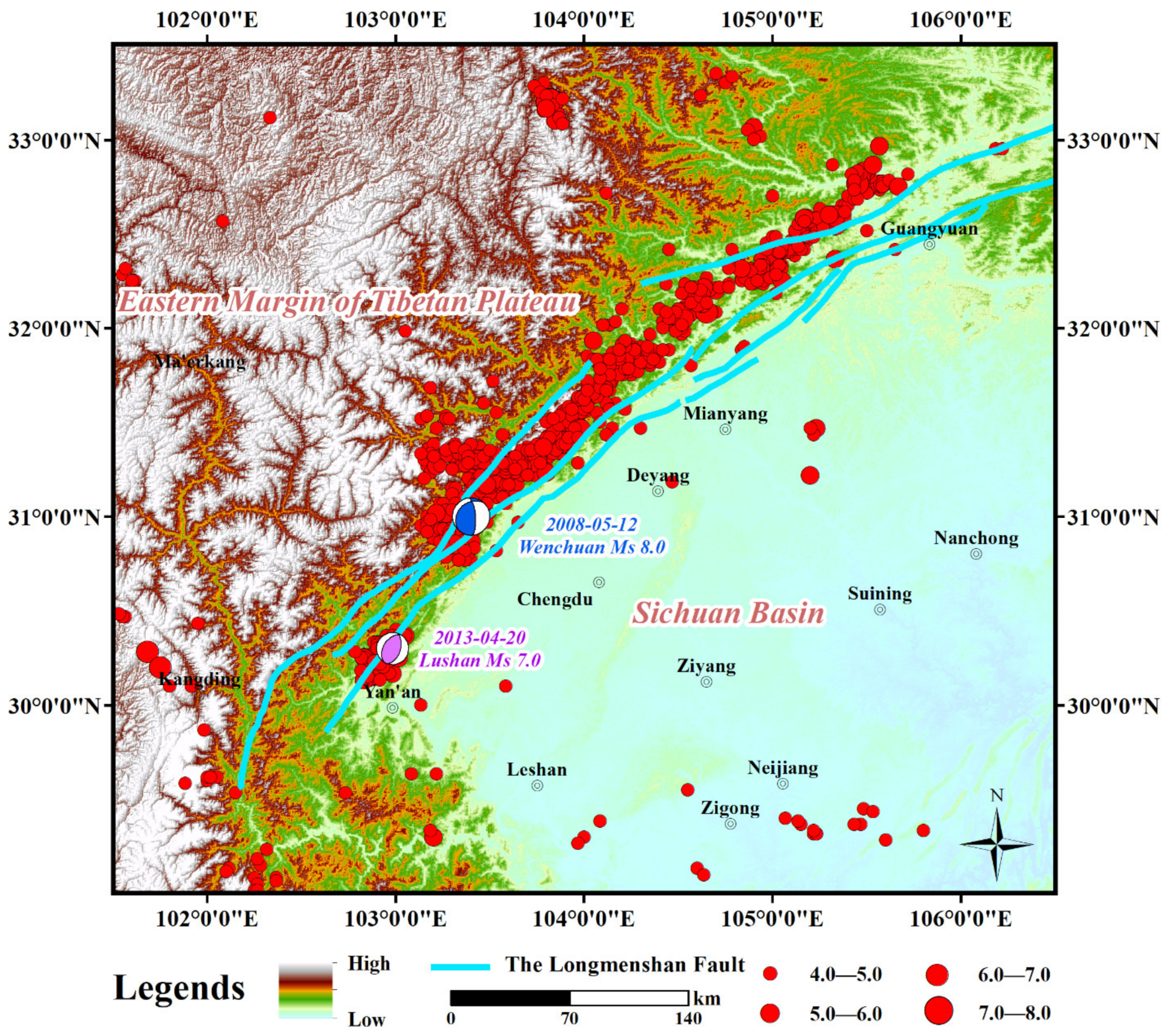
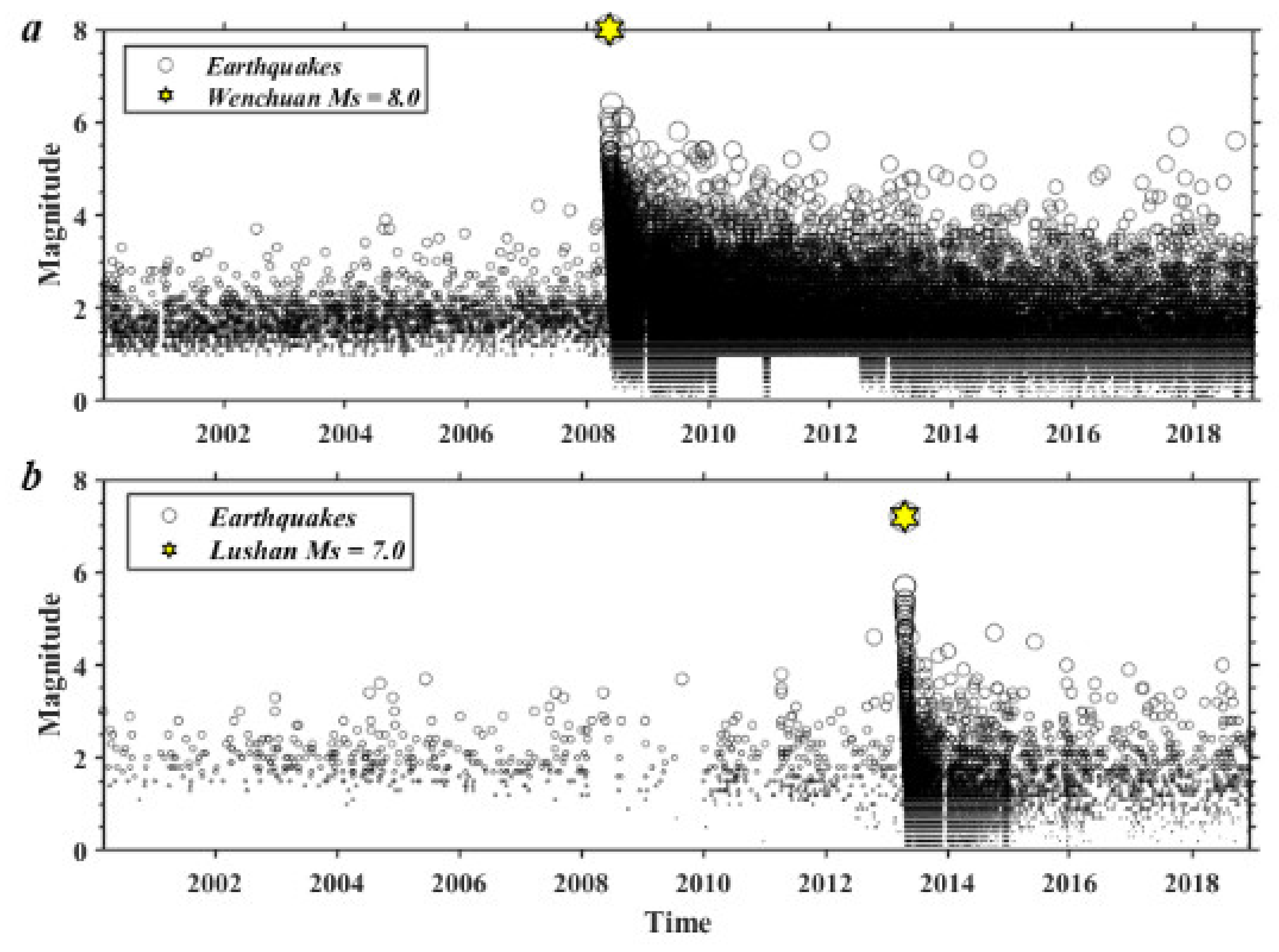
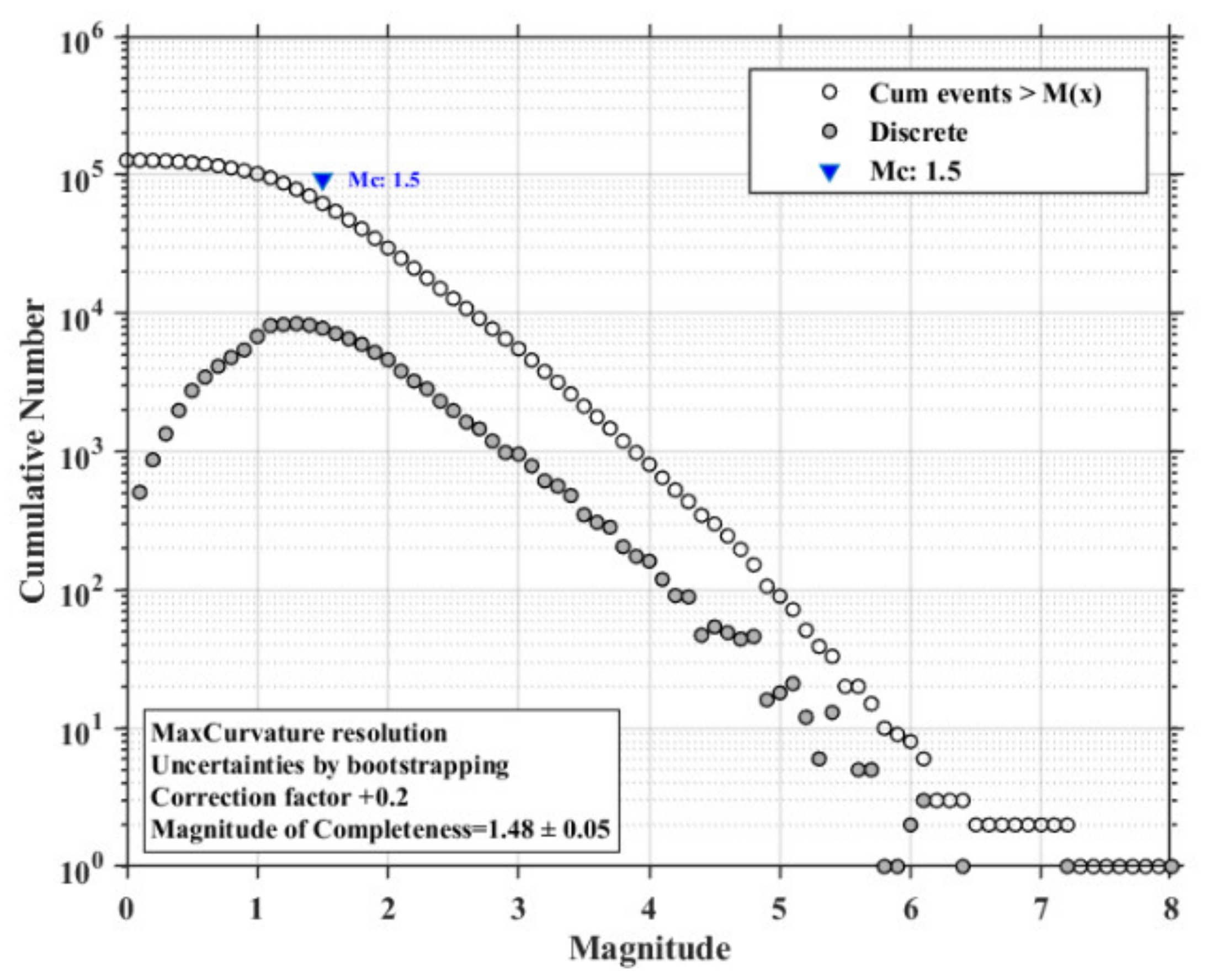
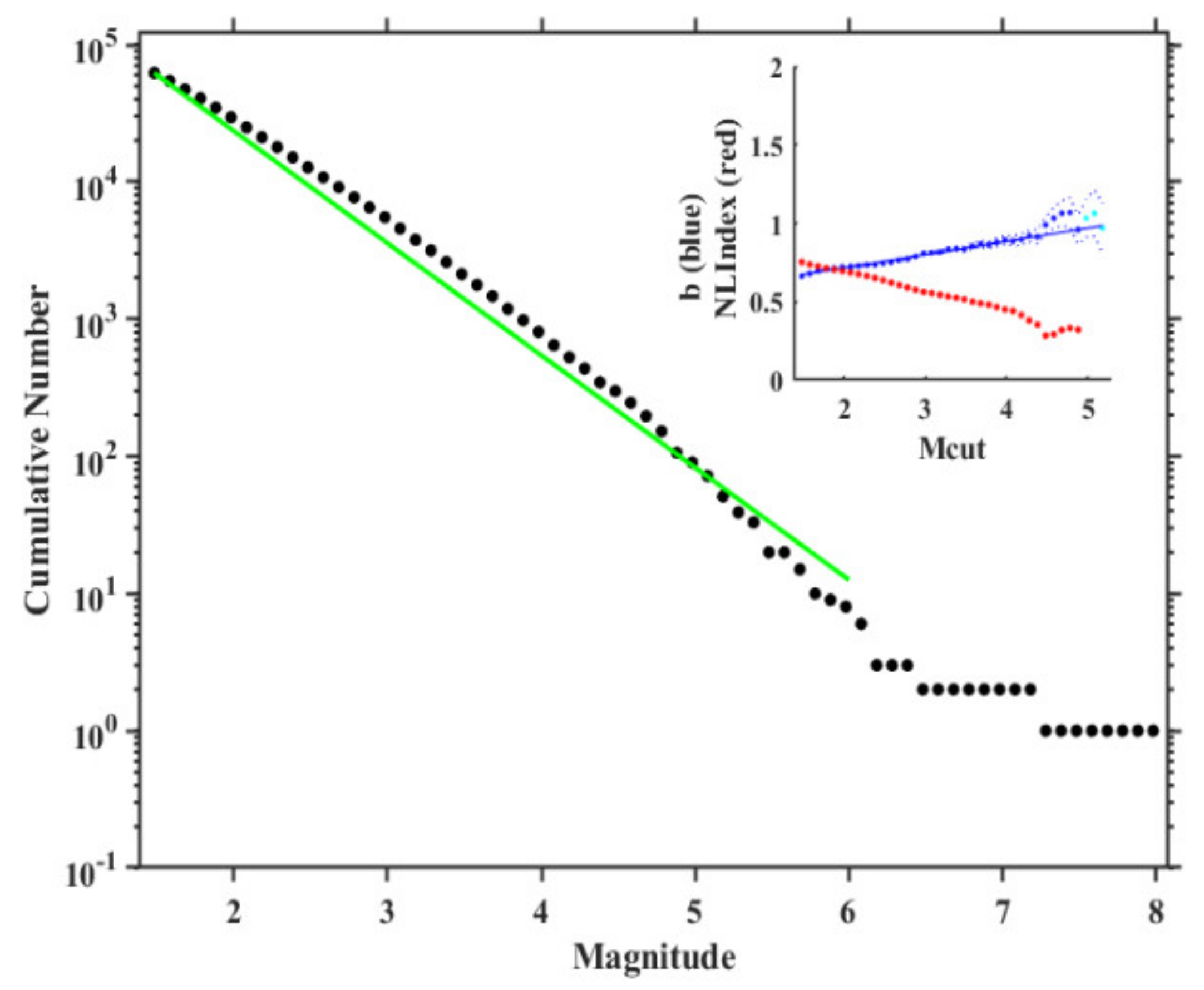
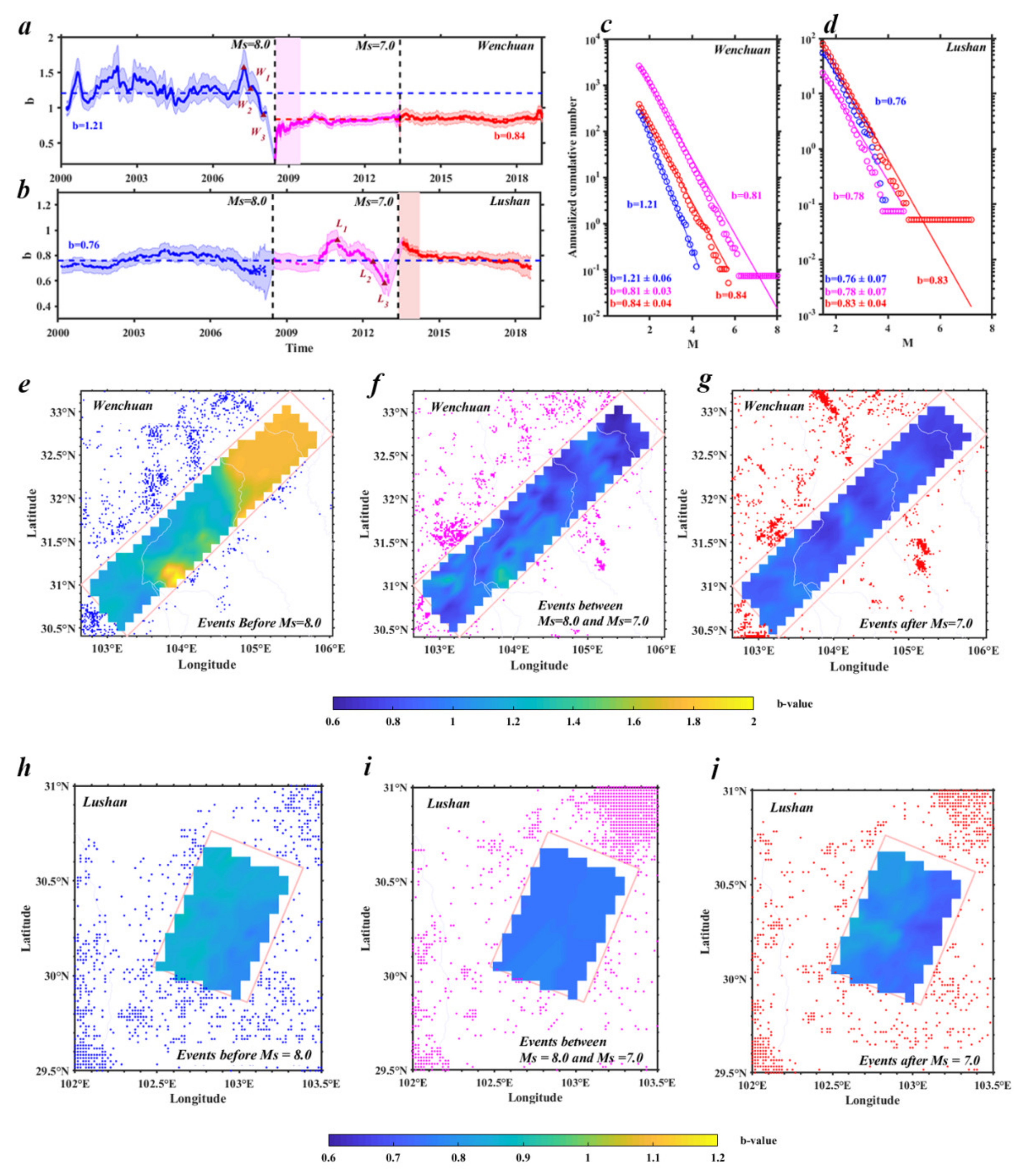

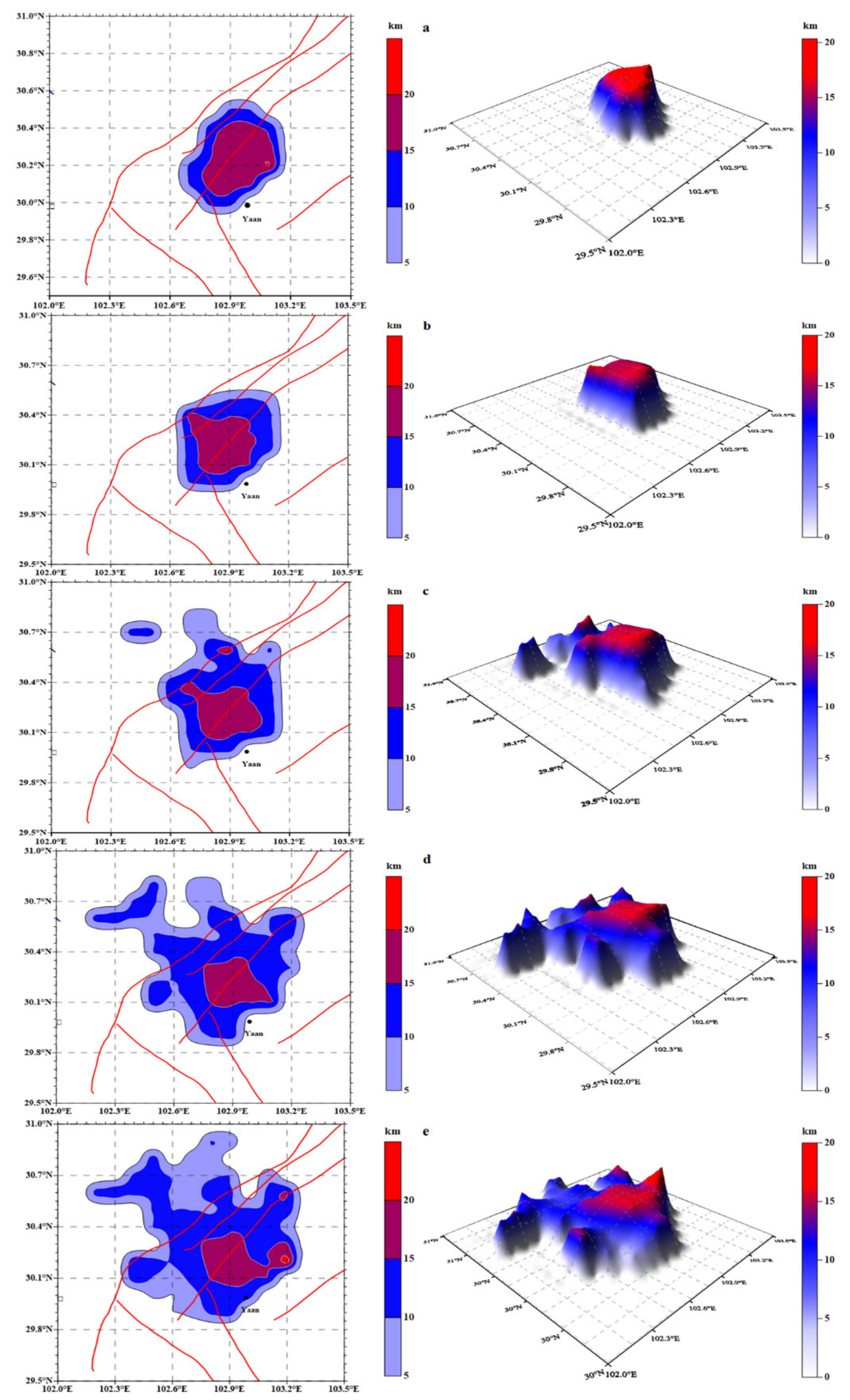
| Windows | ΔAIC | Pb |
|---|---|---|
| W1 and W2 | 2.6 | 0.03 |
| W2 andW3 | 9.9 | 9.5 × 10−4 |
| W1 and W3 | 28.9 | 7.1 × 10−8 |
| L1 and L2 | 2.6 | 0.03 |
| L2 and L3 | 4.6 | 0.01 |
| L1 and L3 | 20 | 5.9 × 10−6 |
Publisher’s Note: MDPI stays neutral with regard to jurisdictional claims in published maps and institutional affiliations. |
© 2021 by the authors. Licensee MDPI, Basel, Switzerland. This article is an open access article distributed under the terms and conditions of the Creative Commons Attribution (CC BY) license (https://creativecommons.org/licenses/by/4.0/).
Share and Cite
Hui, C.; Cheng, C.; Shen, S.; Gao, P.; Chen, J.; Yang, J.; Zhao, M. The Effect of the Wenchuan and Lushan Earthquakes on the Size Distribution of Earthquakes along the Longmenshan Fault. Appl. Sci. 2021, 11, 8534. https://doi.org/10.3390/app11188534
Hui C, Cheng C, Shen S, Gao P, Chen J, Yang J, Zhao M. The Effect of the Wenchuan and Lushan Earthquakes on the Size Distribution of Earthquakes along the Longmenshan Fault. Applied Sciences. 2021; 11(18):8534. https://doi.org/10.3390/app11188534
Chicago/Turabian StyleHui, Chun, Changxiu Cheng, Shi Shen, Peichao Gao, Jin Chen, Jing Yang, and Min Zhao. 2021. "The Effect of the Wenchuan and Lushan Earthquakes on the Size Distribution of Earthquakes along the Longmenshan Fault" Applied Sciences 11, no. 18: 8534. https://doi.org/10.3390/app11188534
APA StyleHui, C., Cheng, C., Shen, S., Gao, P., Chen, J., Yang, J., & Zhao, M. (2021). The Effect of the Wenchuan and Lushan Earthquakes on the Size Distribution of Earthquakes along the Longmenshan Fault. Applied Sciences, 11(18), 8534. https://doi.org/10.3390/app11188534







